
About UsThe Numismatic Bibliomania Society is a non-profit organization promoting numismatic literature. For more information please see our web site at coinbooks.org SubscriptionsThose wishing to become new E-Sylum subscribers (or wishing to Unsubscribe) can go to the following web page link MembershipThere is a membership application available on the web site Membership Application To join, print the application and return it with your check to the address printed on the application. Membership is only $15 to addresses in the U.S., $20 for First Class mail, and $25 elsewhere. For those without web access, write to: David M. Sundman, Treasurer AsylumFor Asylum mailing address changes and other membership questions, contact David at this email address: dsundman@LittletonCoin.com SubmissionsTo submit items for publication in The E-Sylum, just Reply to this message, or write to the Editor at this address: whomren@gmail.com
BUY THE BOOK BEFORE THE COIN |
- WAYNE'S WORDS: THE E-SYLUM DECEMBER 8, 2013
- ASYLUM JULY-SEPTEMBER 2013 ISSUE PUBLISHED
- NEW BOOK: FAKING IT!: A HISTORY OF COUNTERFEITING IN CANADA
- BOOK REVIEW: GLASGOW NUMISMATIC CONGRESS PROCEEDINGS 2009
- 2014 MEMPHIS PAPER MONEY SHOW SPEAKERS SOUGHT
- EDITOR WANTED FOR NEW 1804 DOLLAR BOOK BY MARK FERGUSON
- NOTES FROM E-SYLUM READERS: DECEMBER 8, 2013
- MORE ON THE REPRINT OF RIDDELL'S 1845 MONOGRAPH
- THE CLOCKS OF DAVID RITTENHOUSE
- DISCUSSION: TOOLS AND TIPS FOR NUMISMATIC PUBLISHERS
- 2014 AMERICAN PLATINUM EAGLE DESIGNS
- NOBLE TO SELL THE COPPER CHARLOTTE MEDAL OF AUSTRALIA
- PISTRUCCI'S ST GEORGE AND DRAGON THROUGH THE YEARS
- THE 1710 BOLIVIAN “HEART” 8 REALES
- THE CHENNAI MUSEUM'S ROMAN AND BYZANTINE CATALOGUE
- GUPTA-ERA GOLD COIN FIND MYSTERY
- JESSE OWENS' 1936 OLYMPIC GOLD MEDAL
- THE PRE-HISTORY OF THE US DOLLAR
- THE UNWANTED, UNLOVED U.S. DOLLAR COIN
- FEATURED WEB SITE: CAMP MONEY
Click here to access the complete archive
To comment or submit articles, reply to whomren@gmail.com
WAYNE'S WORDS: THE E-SYLUM DECEMBER 8, 2013

New subscribers this week include David Kirk. Welcome aboard! We have 1,682 email subscribers, plus 256 followers on Facebook.
This week we open with information on the new issue of our print journal, The Asylum, and two new numismatic books. Other topics include the 2009 Glasgow Numismatic Conference, the 2014 Memphis Paper Money Show, and an opportunity to edit a new book on the 1804 Dollar.
To learn more about the U.S. / Philippine Coins book, Riddell's Monograph on the Silver Dollar, the clock of first U.S. Mint Director David Rittenhouse, tools and tips for numismatic authors and editors, and the 2014 American Platinum Eagle designs, read on. Have a great week, everyone!
Wayne Homren
Editor, The E-Sylum
ASYLUM JULY-SEPTEMBER 2013 ISSUE PUBLISHED
-
 John N. Lupia III - A Peek into a New Book: American Numismatic Auctions to 1875
John N. Lupia III - A Peek into a New Book: American Numismatic Auctions to 1875
- Bradley S. Karoleff - Limited-Edition Silver Coin References: The Connoisseur's Library Updated
- Myron Xenos - "You Don't Say": Numismatic Quarterly Quiz
- Lyman H. Low - The Preface to Lyman Low's December 1883 Numismatic Literature Fixed-Price List
- Eric P. Newman - More Collectors Reveals Need for New Literature
- Leonard D. Augsburger - Numismatic Literature for the Liberty Seated Half Dollar Collector
- Bill Febuary - The Most Fabulous Set of Books on California Currency
- David Fanning - Off the Shelf
- Wayne Homren - Book Review: History of Collecting Confederate States Paper Money, vol. 1, by Pierre Fricke and Fred Reed
To read the earlier E-Sylum article, see: www.coinbooks.org/club_nbs_member_app.html
NEW BOOK: FAKING IT!: A HISTORY OF COUNTERFEITING IN CANADA
 Anyone who thought they would leave a meeting about a book about counterfeiting money with the tools to become selfmade millionaires - so to speak - came away sorely disappointed on Nov. 9. For the rest who came to the Mississippi Valley Textile Museum in Almonte for the right reasons were treated to a presentation by authors James Powell and Jill Moxley for their new book Faking It! A History of Counterfeiting in Canada.
Anyone who thought they would leave a meeting about a book about counterfeiting money with the tools to become selfmade millionaires - so to speak - came away sorely disappointed on Nov. 9. For the rest who came to the Mississippi Valley Textile Museum in Almonte for the right reasons were treated to a presentation by authors James Powell and Jill Moxley for their new book Faking It! A History of Counterfeiting in Canada.
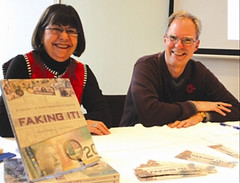 The book took three years to write, and drew upon the help of not only the Royal Canadian Mounted Police, but also the Bank of Canada's national currency collection - once they knew that their book was legit, of course. In fact, the bank even helped out with some of the book's financing too, not surprising since, well, they have a license to print money: no, really. When it came to statistics and pictures, "we owe a big debt to the RCMP," said Moxley, no pun intended, of course. "We hope that it is fun to read and scholarly at the same time," she added.
The book took three years to write, and drew upon the help of not only the Royal Canadian Mounted Police, but also the Bank of Canada's national currency collection - once they knew that their book was legit, of course. In fact, the bank even helped out with some of the book's financing too, not surprising since, well, they have a license to print money: no, really. When it came to statistics and pictures, "we owe a big debt to the RCMP," said Moxley, no pun intended, of course. "We hope that it is fun to read and scholarly at the same time," she added.
Powell had said he wanted to have the book ready for November - of 2011, in time for when the Bank of Canada's new $100 bills hit the market. Well, clearly that didn't happen, but now they are out in time for the new polymer $5 and $10 bills, so it is more likely that people - especially poorer people - will see the changed bills and be thinking about fighting counterfeiting.
"They are probably the most secure and safe currency in the world," said Powell.
To read the complete article, see: Book on counterfeiting, Faking It!, is the real deal (www.insideottawavalley.com/news-story/4245141-book-on-counterfeiting-faking-it-is-the-real-deal/)
To purchase the book on Amazon, see: Faking It! A History of Counterfeiting in Canada (www.amazon.com/Faking-It-History-Counterfeiting-Canada/dp/1771230444)
THE BOOK BAZARRE
BOOK REVIEW: GLASGOW NUMISMATIC CONGRESS PROCEEDINGS 2009
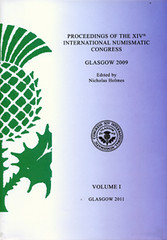 The XIVth International Numismatic Congress in Glasgow was really an impressive event. In 124 sessions – most of them at the same time – 550 numismatists came together attending for three and a half days 375 lectures, looking at 31 posters and visiting some official events too. To admit it immediately, not all of the 375 lectures have been published. However, the pure number and diversity of the contributions is impressive. The heavyweight proceedings are published in two volumes of over 2,200 pages and with some 250 contributions in five languages.
The XIVth International Numismatic Congress in Glasgow was really an impressive event. In 124 sessions – most of them at the same time – 550 numismatists came together attending for three and a half days 375 lectures, looking at 31 posters and visiting some official events too. To admit it immediately, not all of the 375 lectures have been published. However, the pure number and diversity of the contributions is impressive. The heavyweight proceedings are published in two volumes of over 2,200 pages and with some 250 contributions in five languages.
All these essays offer a good insight into the current research since many numismatists seize the opportunity of informing their colleagues about their current studies during this International Congress. The Greek section contains 55 contributions, 77 lectures are in the Roman section. 11 articles represent Celtic coins and 13 papers deal with interdisciplinary subjects in general. 44 articles cover Mediaeval topics, to the rich numismatics of early Modern Western Europe, however, only the humble number of 16 essays were dedicated. Another 16 studies dealt with Islamic and Far Eastern coins while only 8 contributions remain for classical and modern medals. 19 papers concentrated on numismatics in general and in conjunction with the history of research.
Among the authors you will find all important numismatists of the world. Just one more reason for purchasing these books for one’s own library. Oh, by the way, the next International Numismatic Congress will take place in Taormina September 21-25, 2015. We wonder if more lectures will be dedicated to modern numismatics then.
You can order the two volumes directly with the publisher. If you wish to do so, just go to the Spink website.
To read the complete article, see: The Proceedings of the International Numismatic Congress Glasgow 2009 (www.coinsweekly.com/en/News/4?&id=2452)
To order from Spink Books, see: Proceedings of the XIVth International Numismatic Congress Glasgow 2009 by Holmes, N (Ed.) (www.spinkbooks.com/product.php?xProd=17&xSec=7)
2014 MEMPHIS PAPER MONEY SHOW SPEAKERS SOUGHT

Memphis Speakers Series Call for Papers
2014 Memphis International Paper Money Show June 12-15, 2014
Memphis is the paper money speaking event of the year! Be there with your great presentation!
We invite presentations on any fiscal paper or fiscal paper tie-in topic. We will have a packed program. Talks are scheduled on Friday and Saturday.
Deadline for submissions is March 15th so we have adequate time to organize the program and to send out press releases advertising your talk.
Talks are scheduled on the hour throughout the show. Each talk is allotted 50 minutes, which includes time for questions. Speakers arrive 10 minutes before the hour for setup.
You must use Powerpoint for your visuals. No exceptions. Lavishly illustrate your talk. Bring your own laptop or submit a disk or thumb drive with your presentation to Peter Huntoon two weeks in advance of the show.
You are encouraged to mount a parallel exhibit in the exhibition area. Check the Memphis International Paper Money Show website for exhibit details.
Speaker application requirements:
(1) list of presenter(s) with full contact information for each,
(2) title of talk,
(3) concise newsworthy description of the content of your talk consisting of two or three sentences,
(4) advise if you need up to three display cases for show-and-tell items.
Send applications to peterhuntoon@embarqmail.com
For more information on the show, see: International Paper Money Show (www.memphisipms.com)
EMPLOYMENT OPPORTUNITY!
Live and Work in Southern CaliforniaStack’s Bowers Galleries offers an important employment opportunity for the right person. We are seeking an experienced numismatist in the American series—coins, tokens, medals, and paper money—to work with our “dream team” of catalogers, building on the tradition of the Ford, Eliasberg, Bass, Cardinal, Norweb, Battle Born and other great collections.
If you can write in an authoritative and compelling manner with a high degree of accuracy, this may be just right for you! You will be working in Irvine, a modern community in dynamic Orange County, California—one of the finest areas to live. We offer generous benefits including medical and dental coverage, 401K plan, and more. Our offices are in our own modern, state-of-the art building with all amenities.
If you would like to be considered for this position please contact Q. David Bowers by mail or by email with your resumé, samples of your past writing (on numismatics or other subjects), and salary requirements: Mail to the attention of Q. David Bowers, PO Box 1804, Wolfeboro, NH 03894. Email to: Ckarstedt@stacksbowers.com
EDITOR WANTED FOR NEW 1804 DOLLAR BOOK BY MARK FERGUSON
Mark Ferguson writes:
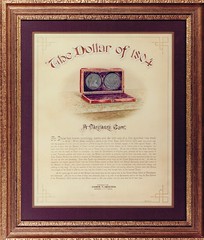 I’m looking for a qualified editor to edit my new book, The Dollar of 1804 – The U.S. Mint’s Hidden Secret. I have a mid-January deadline for the editing work to be completed, for a release in April at the Central States Numismatic Society convention. The book is a creative non-fiction work covering the true story of the Dexter 1804 Dollar, revealing major discoveries about this famous rarity and other 1804 Dollars – information not discovered by other researchers and authors.
I’m looking for a qualified editor to edit my new book, The Dollar of 1804 – The U.S. Mint’s Hidden Secret. I have a mid-January deadline for the editing work to be completed, for a release in April at the Central States Numismatic Society convention. The book is a creative non-fiction work covering the true story of the Dexter 1804 Dollar, revealing major discoveries about this famous rarity and other 1804 Dollars – information not discovered by other researchers and authors.
Confidentiality about these discoveries is required until the book’s release. Remuneration is negotiable. I’m also looking for illustrations pertinent to this story, such as anything relevant surrounding Adolph Weyl and photos that might exist regarding the May 14-15, 1885 Chapman sale at the sale room of Stan. V. Henkels & Co. – Auctioneers, 1117 Chestnut Street, Philadelphia, Pennsylvania or the Henkels building or anything else interesting regarding the “Dexter Dollar” story. I can be reached at 920-233-6777 or mark@MFrarecoins.com. Thank you.
NOTES FROM E-SYLUM READERS: DECEMBER 8, 2013
Milavic Fixed Price List on Ancient Numismatics Anthony Milavic is selling by fixed price list an extensive collection of numismatic reference books and other books that may be of interest to collectors of ancient coinage. Thanks to Tom Kays for putting us in touch with Anthony, who can be reached at majusmcret@aol.com
Several books have already been sold, but quite a few titles remain on the 17-page list, with prices ranging from $0.91 to $1,099.
Fort McHenry Exhibits Russ Sears writes:
It has taken me some time (as usual) but attached is a photo of me and Jane (my wife) in front of part of the exhibits at Fort McHenry National Monument and Historic Shrine here in Baltimore. The items in this exhibit are ours along with pieces in a couple other exhibits. The current exhibits portray anniversaries of the Star Spangled Banner in 1889, 1914 and 1964. Next year's exhibit will focus on the Battle of Baltimore.

To read the earlier E-Sylum article, see: NOTES FROM E-SYLUM READERS: SEPTEMBER 29, 2013 : Fort McHenry and Fire Museum of Maryland Exhibits (www.coinbooks.org/esylum_v16n40a07.html)
John and Nancy Wilson Remember Gar Travis John and Nancy Wilson write:
It was only recently that we heard of the passing of our friend Gar Travis. He was an outstanding numismatist and worked very hard for the ANA in the Representatives Program for many years. In 1995 he received the ANAs - Outstanding Regional Coordinators Award.
In 1999 he received the ANAs Glenn Smedley Memorial Award. As President, I was honored to be able to give Gar a President's Award in March, 2003. We recall several shows where Gar had a bourse table and represented the ANA. At times we even shared an ANA table. He always promoted collecting and the numismatic hobby. We know that his knowledge and enthusiasm for collecting coins rubbed off on many of the young and old that he talked to.
As an ANA recruiter he received the Century Club award in 2004. Not long ago we heard that his health was declining, and it was a very sad day when we heard he had passed away. Gar had a great passion, love, knowledge and enthusiasm for numismatics and life which will be sorely missed by everyone who crossed this "Numismatic Luminaries" path. With condolences to the family, Rest in Peace Gar, as we will never forget you.
To read the earlier E-Sylum article, see: NOTES FROM E-SYLUM READERS: DECEMBER 1, 2013 : More on Gar Travis (www.coinbooks.org/esylum_v16n49a08.html)
More on Collective Terms in Numismatics Roger Siboni writes:
I absolutely loved the piece on Numismatic terms. Everything! I had a pretty challenging day before I read this and it really brought a smile to my face. I loved Lipton's excerpt. I went out and bought a few hardcover first editions (about $20 each!). One for me and others for a few Christmas gifts. What a delight to give someone!
And the Numismatic terms were brilliant.......... "a hope of submissions" ......bravo!
Harvey Stack writes:
I really enjoyed your publishing of "word play" as it shows how authors and cataloguers and collectors use and misuse the English language. I guess we all like to have a "play on words" and it is fun reading the use and misuse of the words.
I don't believe that "editors" was included among the groups for which a collective descriptor was offered.
To read the earlier E-Sylum article, see: COLLECTIVE TERMS IN NUMISMATICS (www.coinbooks.org/esylum_v16n49a15.html)
More on Phone Numbers on Letterheads Regarding phone numbers on letterheads, Phil Iversen writes:
In going through some Mehl items that I have there is no phone number listed as mostly all transactions were done only through the mail. The only thing that I can find that came close is a 1941 letter referring to a cable address of “Mehl Fort Worth” on it. I checked an auction catalog from 1955 and still no phone number was listed. He may have had one and it might be found in an old telephone directory, if it was not unlisted, by somebody who lives in the Fort Worth area. I presume that only a select few dealers and other people that he dealt with new of it though.
To read the earlier E-Sylum article, see: NOTES FROM E-SYLUM READERS: DECEMBER 1, 2013 : Query: When Did Phone Numbers Become Commonplace? (www.coinbooks.org/esylum_v16n49a08.html)
Dr. Lewis Feuchtwanger Regarding last week's Featured Web Page, Ginger Rapsus writes:
I was delighted to find this site. One of my retirement gifts last month was a Feuchtwanger cent.
To read the earlier E-Sylum article, see: FEATURED WEB PAGE: LEWIS FEUCHTWANGER (www.coinbooks.org/esylum_v16n49a19.html)
More on the Feuchtwanger R. E. Russell Token Aaron Packard writes:
 As an update to the R.L. Baker article, I was able to find the location of
his garden/mercantile on an 1850 map of Columbia. I was also able to
finally determine the rightful spelling of Robert "R.E." Russell of
Columbia. Like the token, his name is spelled with two 'L's. I verified this
with the 1850 U.S. Federal Census. Both the map and the census were added
as updates to the article.
As an update to the R.L. Baker article, I was able to find the location of
his garden/mercantile on an 1850 map of Columbia. I was also able to
finally determine the rightful spelling of Robert "R.E." Russell of
Columbia. Like the token, his name is spelled with two 'L's. I verified this
with the 1850 U.S. Federal Census. Both the map and the census were added
as updates to the article.
To read Aaron's updated article, see: The Curious R.E. Russell Token Decrypted? (www.novanumismatics.com/engraving/the-curious-r-e-russell-token-decrypted/)
To read the earlier E-Sylum article, see: POSSIBLE ATTRIBUTION FOR THE FEUCHTWANGER R. E. RUSSELL TOKEN (www.coinbooks.org/esylum_v16n49a13.html)
More on the U.S. / Philippine Coins book
Tom Culhane of The Elusive Spondulix responded to my request for more information on his book on U.S. / Philippine Coins. Thanks!
 The U.S./Philippine Coins book originally written by Lyman Allen was updated and Edited by Tom Culhane. The 7th edition of this work was completely revamped and now starts with the Spanish Philippine coin series since Culhane felt the opening of the Suez Canal profoundly influenced The Philippines.
The U.S./Philippine Coins book originally written by Lyman Allen was updated and Edited by Tom Culhane. The 7th edition of this work was completely revamped and now starts with the Spanish Philippine coin series since Culhane felt the opening of the Suez Canal profoundly influenced The Philippines.
All new sections include the historical overview, market review, and various specialty items such as Wilson dollars and sea salvaged coins.
Culhane, a specialist in Philippine coins for more than a decade, is a former grading consultant to both PCGS and NGC who acquired permission from both grading firms to include their latest population reports in the book. Culhane, who has written the introduction to the Offical Blackbook Price Guide to United States Coins for the past 18 years has monitored the U.S. Philippine's section of prices since its inception, along with doing the Philippine and U.S. Philippine section of the Offical Blackbook Price Guide to World Coins.
Culhane a full time coin dealer since 1979 owns The Elusive Spondulix, a rare coin firm in Union, NJ. Due to his wide range of coin knowledge Culhane has in the past been consulted by the television program "Jeopardy" to verify numismatic questions for the show.
U.S./Philippine Coins sells for $28.50 but is offered to any Numismatic Bibliomania Society member for $22 postpaid and the book may be ordered from:
The Elusive Spondulix
Attn. Tom Culhane
954 Stuyvesant Avenue
Union, NJ 07083
www.rarecoin.com
To read the earlier E-Sylum article, see: NEW BOOK: U.S. / PHILIPPINE COINS 2012 7TH EDITION (www.coinbooks.org/esylum_v16n49a04.html)
MORE ON THE REPRINT OF RIDDELL'S 1845 MONOGRAPH
Ken Berger writes:
I have copy # 383 of Riddell's Monograph reprint. I've had it for years. I obtained it from a fellow San Diego collector, who obtained it in July 2003.
Bill Burd writes:
I have the 1969 reprint and it is number 403. I do not have an original.
Bill Gibbs writes:
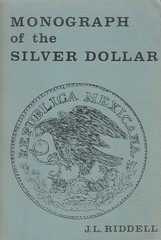 Coin World published two short articles in 1969 about the availability of the John Leonard Riddell monograph reprint. The first article appeared in the June 4, 1969, issue, noting that the book was available from an Edward P. Beals in California for $10. The second article noted that the book had been reprinted by the Sociedad Numismatica de Mexico and was available from that society, also for $10. Both articles had brief biographies of Riddell but provided no details about the decision to reprint his monograph.
Coin World published two short articles in 1969 about the availability of the John Leonard Riddell monograph reprint. The first article appeared in the June 4, 1969, issue, noting that the book was available from an Edward P. Beals in California for $10. The second article noted that the book had been reprinted by the Sociedad Numismatica de Mexico and was available from that society, also for $10. Both articles had brief biographies of Riddell but provided no details about the decision to reprint his monograph.
The copy of the reprint in Coin World’s library is No. 80 of 550.
Riddell is a fascinating figure: brilliant, driven, mercurial. He knew nothing about melting and refining when President Van Buren appointed him to the position of melter and refiner at the New Orleans Mint in 1839. Some of his early efforts at performing his appointed tasks were disastrous; he lost a considerable amount of gold and silver on January 11, 1840. when glass vessels burst while they were being heated. He was eventually able to produce silver ingots for refining but continued, at least initially, to have problems refining gold, which was brought to the attention of officials in Philadelphia and Washington. However, he grew into the position and became quite skilled. He introduced techniques that would be used into the early 20th century.
He also was unpopular with some employees at the New Orleans Mint because of his actions, and became the subject of numerous complaints.
He fired two employees, claiming they were incompetent, and then sought to have one of his brothers appointed to fill one of the vacancies (another brother had already received an appointment at the facility). When Riddell failed to promote another employee, the disgruntled laborer spread rumors about Riddell, alleging incompetence, stealing, cowardice, default and that he had murdered Riddell’s recently dead wife. Riddell and his brothers tracked down the Mint employee and "chastised him on the piazza of his boarding house." Riddell was charged with assault and battery, and convicted. However, the judge chose to fine Riddell rather than imprison him because of his importance to the Mint. The assault resulted in months of correspondence between New Orleans and officials in the East as Mint superiors sought details on the incident.
Riddell's term as melter and refiner ended on Dec. 4, 1848, when Treasury Secretary Robert J. Walker dismissed him without explanation to the bewildered appointee.
Anyone wanting to learn more about Riddell should seek out one of the best biographies of Riddell, written by Karlem Riess and published Sept. 1, 1977, in Tulane Studies in Geology and Paleontology, two fields in which Riddell excelled. The article can be found at www.tulane.edu/~matas/historical/docs/Riddell_LD_5427_T822.pdf. I used the article for my two-part article on Riddell in the October 11 and October 18, 1999, issues of Coin World .
George Kolbe writes:
Since 2002 Kolbe & Fanning has offered five original Riddells at auction and one in a fixed price list. Two reprints were sold, in 2004 and 2012; the first was part of a 22 item bulk lot. For many years the supply of Riddell reprints overwhelmed the demand but increased interest in recent years has reversed that trend. Partner David Fanning notes that we've had a copy of the reprint for sale on our website for a little while, too.
Dave Ginsburg writes:
I noticed a typo (from my original email) that I missed when I reviewed your draft - the Riddell Mint at New Orleans pamphlet was reprinted in the April 1968 issue of The Numismatist, not in the 1868 issue!
To read the earlier E-Sylum article, see: INFORMATION ON REPRINT OF RIDDELL'S 1845 MONOGRAPH SOUGHT (www.coinbooks.org/esylum_v16n49a07.html)

THE CLOCKS OF DAVID RITTENHOUSE
Al Adams writes:
I am seeking information on and a proper appraiser for an Important 1771 Chippendale Carved Mahogany Tall-Case Clock, by David Rittenhouse. Once appraised, I will be offering the clock for sale. Any help appreciated.
The Smithsonian's David Rittenhouse Tall Case Clock
 David Rittenhouse (1732-1796) was eighteenth-century Pennsylvania's most accomplished clock- and instrument-maker. An avid astronomer, he built complicated astronomical clocks and orreries, or planetary models, that not only kept time but predicted celestial events. These major works, coupled with his notable and widely publicized observations of Venus passing between Earth and the Sun in 1769, established him as a scientific leader and secured him an eminent place in the history of American science.
David Rittenhouse (1732-1796) was eighteenth-century Pennsylvania's most accomplished clock- and instrument-maker. An avid astronomer, he built complicated astronomical clocks and orreries, or planetary models, that not only kept time but predicted celestial events. These major works, coupled with his notable and widely publicized observations of Venus passing between Earth and the Sun in 1769, established him as a scientific leader and secured him an eminent place in the history of American science.
This eight-day clock in a plain walnut case, made about 1770, reminds us, though, that Rittenhouse spent more than twenty years—from about 1750 until the Revolution—making clocks for a living. Largely self-taught, he incorporated standard English features in this timekeeper: the movement has cast brass plates and steel pinions; a seconds pendulum; an anchor escapement; a rack-and-snail striking mechanism; a second hand on the escape wheel arbor; and a calendar. The dial is engraved "David Rittenhouse/Philadelphia."
The lead weights, according to oral tradition, survived the Revolution while most others did not. Probably because they sympathized with the British, the family that owned the clock hid the weights in a well to avoid having them melted down for shot. Ironically, Rittenhouse was one of those responsible for the Pennsylvania Committee of Safety's drive to procure ammunition during the war. His duties included collecting the lead clock weights commonly in use and replacing them with iron ones.
To read the complete article, see: David Rittenhouse Tall Case Clock (americanhistory.si.edu/collections/search/object/nmah_1063413)
Drexel University's Astronomical Musical Clock David Rittenhouse (1732-1796), the maker of Drexel University's Astronomical Musical Clock, was Philadelphia's most noted astronomer, mathematician, scientific instrument maker and surveyor during the 18 th century. His clock dates to c. 1773 and has been regarded as the most important clock in America.
The uppermost dial is an orrery that gives the positions of the then-known planets: Venus, Earth, Mars, Jupiter, Saturn and Mercury.
The lunarium in the center dial shows the phase of the moon at the particular time that appears on the clock.
To read the complete article, see: Drexel University's Astronomical Musical Clock, (www.drexel.edu/drexelcollection/decorativearts.asp)
Chippendale Thirty-Hour Walnut Tall Case Clock David Rittenhouse
Chippendale thirty-hour walnut tall case clock
DAVID RITTENHOUSE (1732-1796), EAST NORRITON
TOWNSHIP OR PHILADELPHIA, circa 1765
The hood with stepped cornice and turned
corner columnettes enclosing a square glazed
door opening to a brass face with applied cast
ornaments at spandrels, roman and Arabic
numerals, and inscribed, “David Rittenhouse,”
above a thumb molded arched door, plain plinth,
and molded base.
To read the complete article, see: Chippendale Thirty-Hour Walnut Tall Case Clock David Rittenhouse (Lot 47) (www.freemansauction.com/sale_pdf/1456.pdf)
Al adds:
 My client's clock is similar to the Smithsonian ~ Behring Center clock.
The case of the Drexel clock is far more elaborate.
My client's clock is similar to the Smithsonian ~ Behring Center clock.
The case of the Drexel clock is far more elaborate.
Subject clock has been owned by my client for more than 50 years. He passed away earlier this year and is now part of his estate. I am working with the executor. I want to have it appraised and then find it a good home, through a private sale or auction. I feel there are numismatist who would appreciate and enjoy owning this important clock. It would be nice to keep it in our numismatic realm.
The clock is in North Ga and hasn't been on public view since he loaned it briefly to Atlanta's High Museum in 1977. I need to find a qualified appraiser and thought you or some of your readers may know of an appraiser.
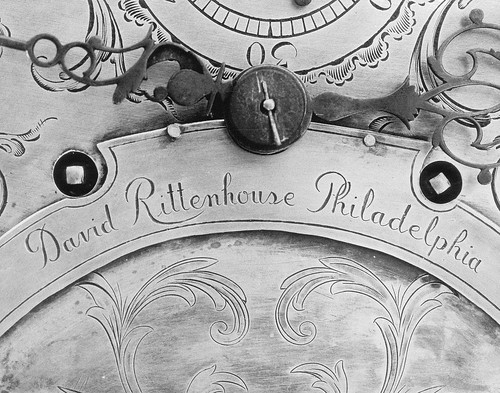
Dave Bowers writes:
Some years ago--perhaps 20--one came up for sale, and I tried via Ed Rochette to get a groundswell movement to have the ANA buy it. I think the price was in the tens of thousands, but not huge. I volunteered to contribute, but it met with no interest.
Anne Bentley of the Massachusetts Historical Society writes:
I'll check in with our horologist, Michael Poisson, who keeps our 9 tall case clocks and assorted mantel clocks in running order. He'll know who is best to appraise this sort of thing.
Joel Orosz writes:
Being a happily married man, I've always steered clear of horology! But seriously, we do own a tall case clock that was made by one of my wife's ancestors, William Upjohn of Exeter. I have never gotten involved in that collecting area, though, so I don't know any clock dealers or people with expertise/competence as appraisers in that field.
It would be cool indeed to have a Rittenhouse clock marking time in anyone's numismatic library--hopefully a subscriber to The E-Sylum will provide it a good home!
Len Augsburger forwarded the query to Bill Bugert, who is a clock maker/repairer. Bill writes:
From my clockmaking days, I do know a number of clockmakers and watchmakers from the Virginia area. The only one I think that would be qualified to appraise the clock would be Donnie Sobel. He owns the Clock Shop of Vienna (VA), is the best clockmaker I know, and the most qualified person I personally know to appraise it.
Also, I am a life member of the American Watchmakers-Clockmakers Institute and I can query them. There are a few nationally known clockmakers that I don’t personally know but their reputation is well-known.
Anne Bentley adds:
Gary Sullivan is a specialist in appraising clocks of all kinds. He just curated the most wonderful musical tall clocks exhibit at the Willard Clock Museum in Grafton as part of the 400 Years of Massachusetts Furniture exhibitions statewide in 2013-4. His website and contact information is at www.garysullivanantiques.com
Dan Hamelberg writes:
I have done business with Delaney Clocks in West Townsend, Mass., and they are very good with special clocks. They are appraisers for the Antiques Roadshow, and probably have the best selection of Tall Case clocks of anyone
THE BOOK BAZARRE
DISCUSSION: TOOLS AND TIPS FOR NUMISMATIC PUBLISHERS
I had a nice phone conversation this week with Dan Gosling, editor of the Royal Canadian Numismatic Association's Canadian Numismatic Journal. We got to talking about the pros and cons of the various tools authors and editors use to create numismatic publications.
The E-Sylum is a pure web-based publication and we deliver our content in HTML via email and our web archive pages. Most other publications are print-based and the most popular format seems to be the Adobe .PDF file format. These files can be printed and also made available on the web or CD/DVDs. The Canadian Numismatic Journal is available in two versions: Flash and Tablet Friendly (jpg).
With a print-based layout format authors and editors have great control of the exact appearance of their pages. The downside to that is that more of work is required to manipulate the layout. Another problem is that .PDF files containing images can grow very large and be difficult to email as attachments.
Some publishers make use of Adobe security features to prevent readers from copying text or require a password for opening files for viewing; some even restrict printing.
We thought we'd open up an E-Sylum discussion asking other numismatic editors and publishers about the tools they use and thoughts on issues such as copyright, restricted printing, passwords etc. What words of wisdom can you share with the rest of us?
2014 AMERICAN PLATINUM EAGLE DESIGNS
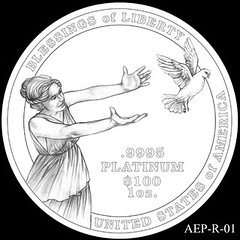
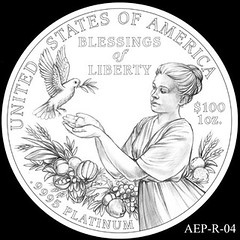
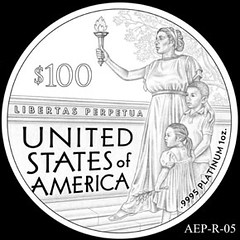
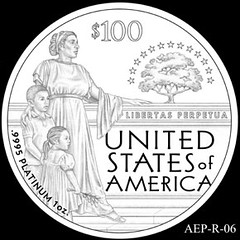
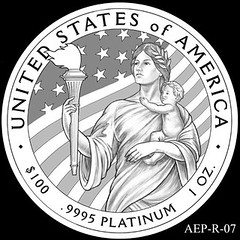

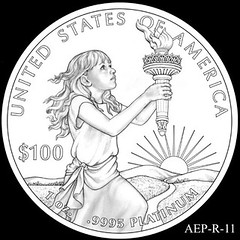
To read the complete article, see: CCAC Review of 2014 American Platinum Eagle Designs (news.coinupdate.com/ccac-review-of-american-platinum-eagle-designs-3043/)
To read the earlier E-Sylum article, see: THE 2013 AMERICAN EAGLE ONE OUNCE PLATINUM PROOF (www.coinbooks.org/esylum_v16n49a09.html)
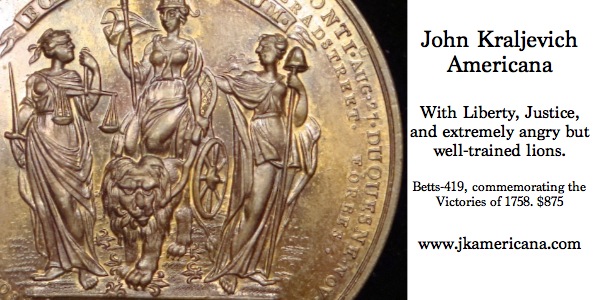
NOBLE TO SELL THE COPPER CHARLOTTE MEDAL OF AUSTRALIA
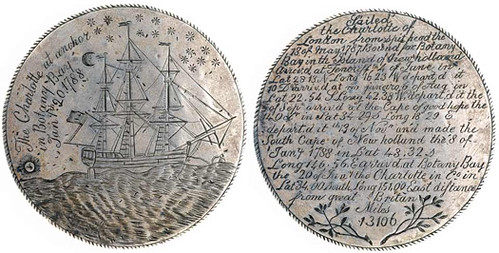
The Charlotte medal in silver is believed to have been engraved on board the First Fleet transport Charlotte as she lay at anchor in Botany Bay before sailing into Port Jackson and unloading her cargo of convicts at Sydney Cove on 26 January 1788.
Inscribed with an account of the voyage from England and an image of the Charlotte, it is acclaimed as Australia’s first colonial work of art, and furthermore, as a unique record of the arrival of the settlers who founded modern Australia.
The 74mm wide medal is believed to have been made from a surgical dish by convicted thief Thomas Barrett at the behest of John White, the ship’s surgeon. White wanted a memento of the historic landing and chose Barrett for the task after he’d displayed remarkable skill at forging coins during the arduous sea voyage.
Alas, Barrett lasted little more than a month in the convict colony, meeting his fate at the end of a hangman’s rope for stealing beef and peas. Not only was he responsible for the historic silver medal, but also a smaller copper version, thought to have been commissioned by White’s personal servant, William Broughton.
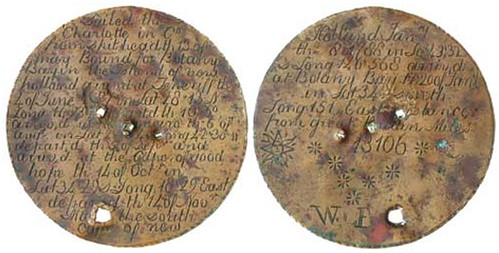
Material for the second medal could have come from copper sheathing used to protect the ship’s hull. The finished piece measured 47mm in diameter and featured an abridged form of the inscription on the silver medal, but no ship.
Sailed the Charlotte of London from spit head the 13 of May 1787. Bound for Botany Bay in the Island of new holland Arriv’d at Teneriff the 4th June in Lat 28.13N Long 16.23 W depart’d it 10 Dec arriv’d at rio janeiro 6 of Aug in Lat 22.54 S Long 42.38 W depart’d it the 5 of Sept arriv’d at the Cape of good hope the 14 Octr in Lat 34.29 S Lon S 18.29 E depart’d it th 13 of Nov and made the South Cape of New Holland the ‘8 of Jany 1788 in Lat 43.32 S Long 146.56E arrived Botany Bay the 20 of Jany the Charlotte in Co in Lat 34.00 South Long 151.00 East distance from Great Britain miles 13106.
The silver Charlotte medal belonging to surgeon John White, who returned to England, remained unknown until it appeared in the famous collection of the Marquess of Milford Haven. Details were published in 1919 in the first volume covering his collection of naval medals.
William Broughton remained in the colony, rising to become an official of significant stature in the Government of New South Wales. His copper Charlotte medal was discovered during the 1940s on the site of a farm in Camden with which he was associated.
To read the complete article, see: What is the Charlotte medal and why is it of such immense significance to Australia? (blog.perthmint.com.au/2013/12/05/what-is-the-charlotte-medal-and-why-is-it-of-such-immense-significance-to-australia/)
To read the complete auction lot description, see: CHARLOTTE MEDAL, undated (1788), in copper (www.noble.com.au/auctions/lot/?id=308954)
To read the earlier E-Sylum articles, see: AUSTRALIA'S CHARLOTTE MEDAL PEDIGREED TO JOHN J. FORD (www.coinbooks.org/esylum_v11n35a08.html) MORE ON THE CHARLOTTE MEDAL PEDIGREE (www.coinbooks.org/esylum_v11n36a15.html)
PISTRUCCI'S ST GEORGE AND DRAGON THROUGH THE YEARS
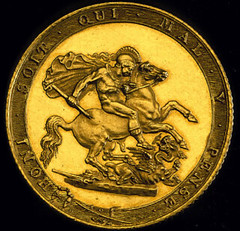 Benedetto Pistrucci created the iconic St. George and Dragon image for the Royal Mint in 1817. The design has been used on crowns off and on to the present day. It's own of my favorite coin designs. This would make for an interesting collection and exhibit. Here are images of a few examples from 1817, 1951 and 2013.
Benedetto Pistrucci created the iconic St. George and Dragon image for the Royal Mint in 1817. The design has been used on crowns off and on to the present day. It's own of my favorite coin designs. This would make for an interesting collection and exhibit. Here are images of a few examples from 1817, 1951 and 2013.


THE BOOK BAZARRE
THE 1710 BOLIVIAN “HEART” 8 REALES
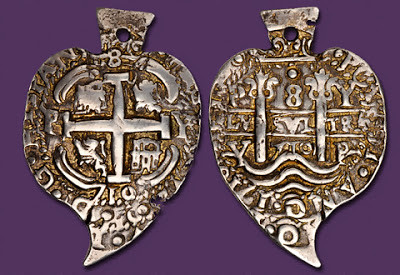
This week we preview a coin which may not visually conform to a coin’s standard dimensions, but nonetheless stands as a true numismatic rarity.
This extremely rare piece has a slightly mysterious background, as its exact purpose is uncertain. One predominant theory is that since the heart shape is similar to “The Most Sacred Heart of Jesus” or simply “Sacred Heart,” they could have been created for special religious purposes. As the religious demographic of Latin America is predominantly Roman Catholic, it seems to be indicative of their religious nature. Regardless of their true purpose, these extraordinary “Heart”-shaped pieces were carefully crafted with special planchets and were carefully aligned to give the piece a medallic die axis. In addition to this special preparation, they are nearly always found pierced for suspension and are often gilt to be worn on display.
The obverse (cross side) prominently displays the Cross of Jerusalem, with the castles and lions of Castille and Leon in the quadrants. The “8” above the cross represents the denomination of 8 Reales, and the first of three full dates “710” is visible below the cross. A good-sized portion of the legend “D.G. HISPAN” is visible. The mintmark “P” for Potosi is to the left of the cross, while the assayer’s mark “Y” is shown at the right.
The reverse (pillar side) contains the Pillars of Hercules, located at the Straits of Gibraltar, indicating the gateway out of the Mediterranean and into the Atlantic. The center Latin legend “PLVS VLTRA” means ‘more beyond’ and most likely refers to the vast uncharted territory beyond the Pillars which the Spanish explored and colonized. The “P” mintmark appears in the upper left and lower right, and the “Y” assayer’s mark appears in the lower left and upper right. The “8” denomination appears in the area above the central legend, with a “710” representing the date below. Waves are represented underneath the Pillars as well. A large portion of the outer legend appears on this side, including the date in the seven o’clock region.
Overall this is a well-struck example with near full legends, three full dates and three clear assayer’s letters. A hint of contemporary gilding is still present in the protected areas giving the piece a lovely marigold tone. This extremely attractive piece is sure to greatly enhance its new owner’s cabinet. We here at Stack’s Bowers are only aware of one other example of a 1710 “Heart” 8 Reales piece, which was lot #193 in our Sale #42 of the 1990 Paul Karon Collection.
To read the complete article, see: World Coin Of The Week: Extremely Rare 1710 Bolivian “Heart” 8 Reales (stacksbowers.com/Blogs/world-coin-of-week-extremely-rare-1710.html)
THE CHENNAI MUSEUM'S ROMAN AND BYZANTINE CATALOGUE
Kavan Ratnatunga forwarded an interesting article about the tribulations of the Chennai Government Museum in publishing a book on Roman and Byzantine coins. He writes:
When I visited the Museum in Chennai in 2012 September, I did purchase the catalog by T.G. Aravamuthan on Venetian Coins, but did not buy the one on roman coins since it did not appear to be interesting at a quick glance. Now I know why.
 A catalogue of coins is the last place to expect a story of intrigue. But the Chennai Government Museum’s book of Roman and Byzantine coins belies that. Beneath its deceptive appearance as a clerical list of objects, the catalogue carries an absorbing story of a temperamental scholar and the museum’s shameful ignorance of its own history. It is also a sad account of the falling standards of Indian museums and raises the question whether they are reliable repositories of the past any more.
A catalogue of coins is the last place to expect a story of intrigue. But the Chennai Government Museum’s book of Roman and Byzantine coins belies that. Beneath its deceptive appearance as a clerical list of objects, the catalogue carries an absorbing story of a temperamental scholar and the museum’s shameful ignorance of its own history. It is also a sad account of the falling standards of Indian museums and raises the question whether they are reliable repositories of the past any more.
The story begins in 2002 when the museum decided to publish a catalogue of Roman and Byzantine coins. The Government Museum, Chennai, holds the largest collection of Roman coins outside Europe — a fact not known to many. In March 2002, the book was released and R. Kannan, then Commissioner of the museum, explained that it was a reprint of the 1942 catalogue compiled by T.G. Aravamuthan, curator of numismatics between 1932 and 1942.
What Kannan and his staff did not know was that the museum had never printed the book and that the publication had actually been abandoned during World War II. Following the government’s decision to divert type-metal for war purposes, the press removed the types from the frames of the composed pages and melted it to make ammunition.
In 2002, when the museum found the proof pages in its files, instead of reading it in full or checking the history, it assumed that it had the entire book and printed 1000 copies. The incomplete proof pages are still sold as a professional catalogue. Senior museum officials insist that the catalogue was completed and published in 1942. A letter dated January 7, 1960, from the assistant superintendent of the museum to Aravamuthan states clearly that the museum had the proofs to only the first part of the catalogue printed in 1942 and nothing was set to print after that.
What the museum officials also did not know was that the museum tried to complete the catalogue in 1952 and again in 1965. By then, the relationship between Aravamuthan and the museum officials had soured. When the irritated superintendent sent a caustic reminder and issued a veiled threat, Aravamuthan, who was almost 70 years old, dared the museum to take action. Why ‘hunt out one who had ceased to be its employee’ and whose work the museum had ‘sabotaged,’ he retorted.
Aravamuthan later relented and promised to complete the catalogue. The trail of the correspondence with the museum, which his family generously shared, ends in 1967. Three years later, in 1970, Aravamuthan died at the age of 80. The catalogue was not completed.
To read the complete article, see: Coining a catalogue (www.thehindu.com/features/magazine/coining-a-catalogue/article5357810.ece)
GUPTA-ERA GOLD COIN FIND MYSTERY
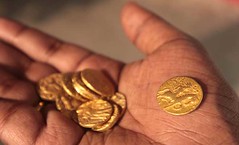 Six months back, news channels flashed the discovery of 11 gold coins, thought to be belonging to the Gupta era (320 AD-550 AD), at Ahiran, 265 km from Murshidabad. The discovery made headlines in newspapers, but the ASI remained unaware of the fact.
Six months back, news channels flashed the discovery of 11 gold coins, thought to be belonging to the Gupta era (320 AD-550 AD), at Ahiran, 265 km from Murshidabad. The discovery made headlines in newspapers, but the ASI remained unaware of the fact.
Last week, ASI director (eastern region) Phanikant Mishra made enquiries from his juniors if they knew about the coins and when the answer was negative, wrote a letter to Murshidabad SP Humayun Kabir demanding to know what had happened and why he was not informed. Meanwhile, the 11 gold coins, each weighing about 10-12 gm, have been kept in an aluminium tiffin box at Suti Police station in Murshidabad.
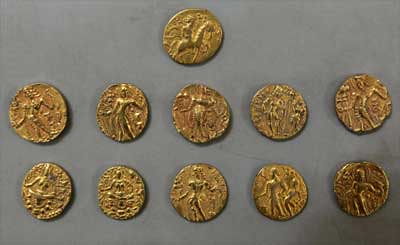
"We are worried about the safety of these priceless objects and we have written to the Directorate of Archaeology and Museums to take them from here but they did not do anything so far,'' Humayun Kabir told The Indian Express.
It was the directorate under the Department of Information and Culture of the state that first rushed to the place when the coins began to be found on May 31 at Ahiran village where NH-34 was being expanded. Soil dug out of mounds at Sealkali in Mirzapur, 15 km away, was brought to lay the road. On May 31 a village woman first saw a coin and took it home and as news spread people came and more coins were found. The police were informed and a team from Suti police station raided the village at Ahiran and recovered 11 coins. However according to unofficial reports, at least 30 coins were recovered and some of them were smuggled out to Bangladesh which is just 10 km away.
To read the complete article, see: ‘Gupta era’ gold coins found in Bengal; 6 months on, ASI yet to act (www.indianexpress.com/news/gupta-era-gold-coins-found-in-bengal-6-months-on-asi-yet-to-act/1202039/)

JESSE OWENS' 1936 OLYMPIC GOLD MEDAL
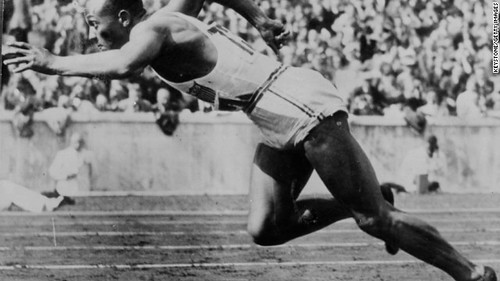
It is one of the most important medals in Olympics history. In 1936 Jesse Owens won it and three others at the Berlin Games, spoiling Adolf Hitler's planned showcase of Aryan superiority.
Imagine the shock to Nazi Party elites when a black American, the son of a sharecropper and grandson of slaves, stared down fascist propaganda, bested his rivals and took home four gold medals.
Hitler was furious, but tens of thousands of ordinary Germans cheered him on.
Owens won the 100- and 200-meter sprints, the long jump and ran the opening leg for the winning 4x100-meter U.S. relay team.
Sports Illustrated chose Owens' feat as the greatest Olympic moment of all time. So auctioneers predict the medal will sell for more than $1 million.
"It leaves one nearly speechless to behold this medal. It survives as one of the world's most poignant symbols of triumph," the vice president of SCP Auctions, Dan Imler, said in a written statement.
The medal was given by Owens to friend Bill "Bojangles" Robinson a few years after the Olympics, and the late entertainer's widow Elaine Plaines-Robinson is selling the medal, the auction house said.
To read the complete article, see: Bidding for Jesse Owens' 1936 gold medal tops $200,000 (www.cnn.com/2013/12/02/us/jesse-owens-gold-medal-auction/)
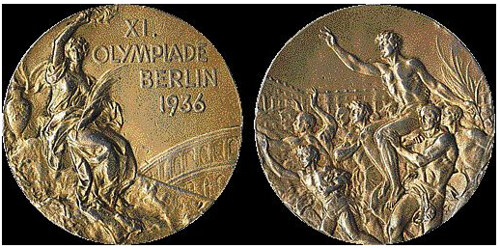
The medal is the only original Owens gold medal in existence, but cannot be traced to the specific event for which it was awarded. Owens earned four gold medals at the Games, for winning the 100-meter race, the 200-meter race and the long jump, and as part of the 4x100-meter relay team.
The medal in the auction has reportedly been in the estate of entertainer Bill “Bojangles” Robinson’s late widow Elaine Plaines-Robinson. Owens gave Bill Robinson the medal because he helped Owens find work in entertainment following Owens’ Olympic exploits, as documented in the biography Mr. Bojangles by N.R. Mitgang.
The other three medals were lost, and Owens was issued a replacement set that was featured as part of the 1976 Freedom Train exhibit. The replacements are now on exhibit at Owens’ alma mater, Ohio State University, as part of their Jesse Owens exhibit.
Ingrid O’Neil, of the Corona Del Mar, Calif., sports and Olympic memorabilia firm bearing her name, said 1936 Berlin gold medals come up at auction occasionally, but cannot usually be traced to a recipient because, prior to 1960, recipients’ names were not engraved on the edge as they have been since that time.
O’Neil said she has been offered 1936 gold medals purported to be among the missing Owens medals on multiple occasions, but those pieces lacked documentation.
To read the complete article, see: Jesse Owens 1936 Olympic gold highlights online auction (www.coinworld.com/articles/jesse-owens-1936-olympic-gold-highlights-onli)
To view the auction lot description, see: Lot #365: JESSE OWENS 1936 OLYMPIC GOLD MEDAL FROM BERLIN GERMANY FROM THE ESTATE OF BILL "BOJANGLES" ROBINSON (catalog.scpauctions.com/JESSE-OWENS-1936-OLYMPIC-GOLD-MEDAL-FROM-BERLIN-GE-LOT26318.aspx)
To read the earlier E-Sylum article, see: FRANCIS CRICK'S 1962 GOLD NOBEL PRIZE MEDAL TO BE AUCTIONED (www.coinbooks.org/esylum_v16n09a34.html)
THE PRE-HISTORY OF THE US DOLLAR
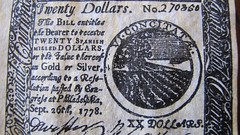 In 1620, the Mayflower set sail from Rotherhithe in East London bound for the New World, carrying religious dissenters in search of a new life overseas. Those first settlers took with them gold and English coins. But they weren't wealthy and they soon ran out of hard money, leaving them without means of buying food, animal skins and other necessities from the indigenous people of the American continent.
In 1620, the Mayflower set sail from Rotherhithe in East London bound for the New World, carrying religious dissenters in search of a new life overseas. Those first settlers took with them gold and English coins. But they weren't wealthy and they soon ran out of hard money, leaving them without means of buying food, animal skins and other necessities from the indigenous people of the American continent.
Jason Goodwin, author of Greenback: the Almighty Dollar and the Invention of America sums up the difficulty: "They simply didn't have any cash. They weren't very loaded when they came over in the first place. And it became quite awkward for the colonists to do exchanges between themselves… it was all very well to barter one thing for another, but of course quite soon you get into quite complex exchanges, and that's where money is so incredibly useful."
Soon after their arrival, the settlers discovered that certain kinds of shell - known as wampum - had great symbolic significance for many native Americans and as such could be exchanged by the English colonists for the things they needed, such as food. In fact, the wampum became so important in the early days of trading in what is now the Eastern seaboard of the US that in 1637 the Massachusetts Bay Colony declared them to be legal tender.
As trade among the settlers themselves became increasingly important, they started to use other goods for bartering. In the northern colonies they used corn and cod, for example, and in the more southerly colonies they also favoured tobacco. Many of these goods were declared legal tender at one time or another, although not all proved successful.
Goodwin also points out that when the settlers tried using nails some were tempted to burn down wooden barns in order to extract the nails, which had a value similar to money.
To read the complete article, see: The pre-history of the US dollar (www.bbc.co.uk/news/magazine-25119865)
THE UNWANTED, UNLOVED U.S. DOLLAR COIN
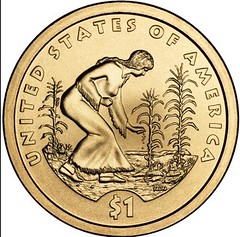 To all the great mysteries of life, add this: Why is the lowly, tarnished penny so revered, and the shiny $1 coin so reviled?
To all the great mysteries of life, add this: Why is the lowly, tarnished penny so revered, and the shiny $1 coin so reviled?
Pennies proliferate. They fill our pockets. Our jars runneth over.
When we drop a penny, we conduct the ultimate cost-benefit analysis: Should I pick it up? Consequently, pennies are everywhere.
But where are your Sacagaweas? And where are all those John Quincy Adams presidential coins?
The answer: in the inventory of the nation's Federal Reserve Banks.
The Federal Reserve Banks hold about $1.4 billion in $1 coins -- enough to meet the demand for the next 40 years.
In fact, far more than half of all $1 coins ever minted are in government vaults.
To read the complete article, see: $1 coins: Unwanted, unloved and out of currency (www.cnn.com/2013/11/28/us/one-dollar-coins/)
FEATURED WEB SITE: CAMP MONEY
This week's Featured Web Site is worldandmilitarynotes.com, a source for information about camp money.The purpose of this web site is to present information about what is sometimes referred to as camp money. Camp money would include Concentration Camps, Ghettos, Internment Camps, Prisoner of War Camps, and Displaced Persons Camps. Research in this area began shortly after World War II by Kisch and shortly after that by Keller. There have been many others that have written books and articles on the subject.This web site will hopefully review and add to the information printed but in an electronic format.
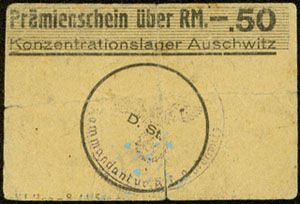
worldandmilitarynotes.com
